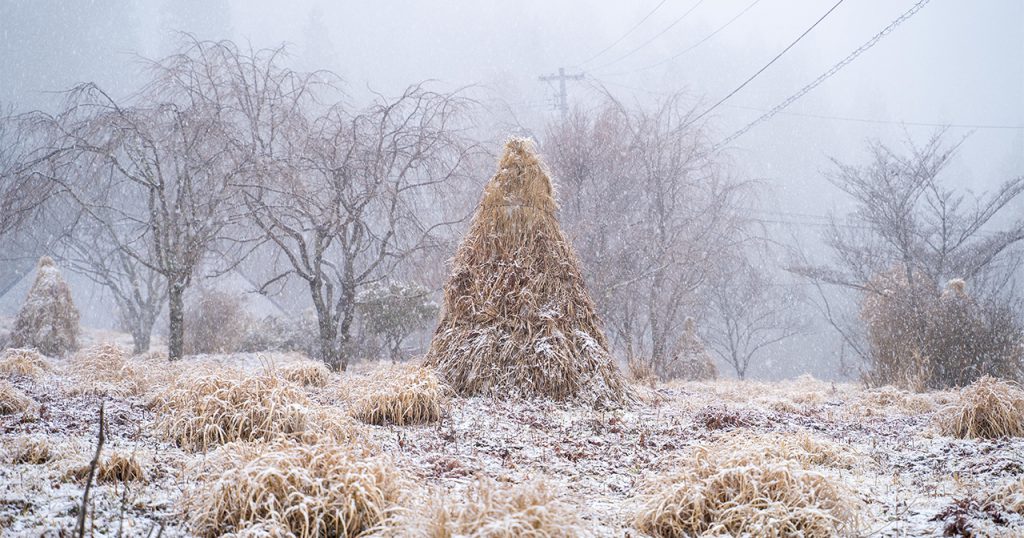[MIYOSHI JIN] Traditions passed down amidst the beauty of nature. Engaging with others during private, hands-on tours. Shigemitsu Kunigane, Owner, Kominka Yado Kuratani Part 1
2020.11.30
Shigemitsu Kunigane, Owner, Kominka Yado Kuratani
Traditions passed down amidst the beauty of nature. Engaging with others during private, hands-on tours.
We are driving quickly down the road to Takamatsu Airport to pick up some guests from overseas staying for two nights and three days.
“Most people just come without any plans,” says Shigemitsu Kunigane.
Shigemitsu Kunigane is owner of a yado or inn in a traditional Japanese house in the Shuzu neighborhood of Miyoshi City’s Ikeda-cho area.
“There are a lot of tiny villages in the mountains of Miyoshi, but it’s hard to give tourists the chance to experience what it’s like to live here and do day-to-day activities. Tourists from overseas are particularly interested in the traditional Japanese lifestyle. I listen to their requests, then coordinate with others in the community and take my guests out to various places in the area.”
The Oboke-Iya region is home to some of Japan’s oldest, most unspoiled landscapes. Homes and farmland are found side-by-side on slopes formed by steep mountains and deep valleys, creating what is one of the most unique landscapes in the world. It is a truly blessed region, where people can feel and experience the climate, lifestyle, and cultural landscape of mountain villages reached by traveling narrow, winding roads.
“The guests made a request, and I proposed a plan where we go to Higashi-Iya where they can make their own soba noodles and have lunch, then we go to Yamashiro, where they can harvest tea leaves. After that, we return to our lodgings. I also plan to take them to some nice scenic spots as we travel,” Kunigane tells us.
For the soba-making experience, tourists can travel deep into Higashi-Iya to learn the art of the local specialty, Iya soba, made from carefully milled home-made flour from sun-dried buckwheat grown pesticide free. Guests learn the secrets of delicious soba, then make their own and enjoy some time around the fireplace with others.
During the tea-leaf picking experience, visitors travel to a tea plantation on a sloping mountainside at an altitude of 600 meters. The temperature difference between day and night contributes to the color and aroma of the tea. Visitors get the chance to make iribancha (roasted bancha tea) in the heat of the oven using the tea leaves they picked themselves – all in a place with a fantastic view. It is a truly exceptional experience.
Kunigane’s guests find themselves overwhelmed by the beauty of the snowy landscape around Higashi-Iya. They often want to return to the area again to see what it looks like as the seasons change.

Kunigane works hard and adapts well, and he gets along well with people in various villages. With connections to so many people, he tries to learn as much as he can from them as well. In every village he goes to, he is welcomed with smiling faces, and we really get a feel for the amazing relationships he has built.
“It’s really important to learn the area and the people when you join a community,” Kunigane says. He owns his own lodgings, but he is also actively looking into creating a fieldwork program for students in his capacity as community coordinator. He talked to us about his feelings about the area and about the younger generations who will take over in the future.
“We need to bring young people back into the rural areas and have them understand the core of how things are made,” he explains.
In the second part of our article, we will look more deeply into the student fieldwork activities.
– – – – –
Kominka Yado Kuratani can be found in a traditional structure originally built 100 years ago to house a sake brewery. The building has been renovated, but the interiors of the rooms are as they were when first built. It has a wonderful atmosphere, reminiscent of days gone by.
Continue to Part 2.
(Interview and article: Michio Yokoyama Photography: Masatoshi Sato)
Related Posts
-
Exploring Oboke Gorge – Part 2 | A Place for Food, Fun… and Monsters?!
The thrilling cliffs of Oboke Gorge are formed by the mighty Yoshino River as it cuts its way throug
2023.03.21
-
Exploring Oboke Gorge – Part 1 | A Natural Wonder of Miyoshi City
The mighty Yoshino River flows across much of Shikoku, and as it cuts its way through the rugged mou
2023.03.20
-
Iya Kanko Ryokan – Part 3 | Inheriting the Tastes of the Iya Valley
Just a few minute walk from the famed Kazurabashi Vine Bridge, the Iya Kanko Ryokan has been welcomi
2023.03.19
-
Iya Kanko Ryokan – Part 2 | A Family-Run Business Where Life is a Juggle
The Kazurabashi Vine Bridge is one of the most renowned sights of the Iya Valley, and just a couple
2023.03.18
-
Iya Kanko Ryokan – Part 1 | A Traditional Inn near the Kazurabashi Vine Bridge
Acclaimed as one of Japan’s Three Unusual Bridges, the Kazurabashi Vine Bridge is one of the most fa
2023.03.17
-
The Shikoku “Yukigassen” Snowball Fight – Part 2 | The Heat of the Battle in Icy Conditions
The 19th annual “Yukigassen” Snowball Fight Tournament was held recently in the deep mountains of Mi
2023.02.19
















